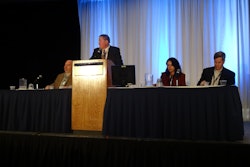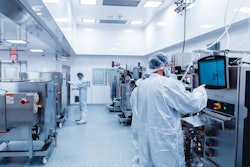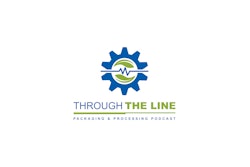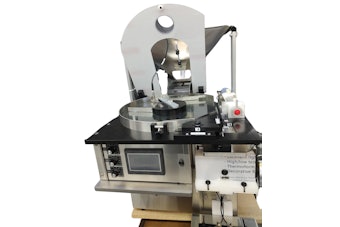In the pharmaceutical cold chain, recent technological innovations have made real-time monitoring of high-value shipments a reality, providing data on temperature, pressure, shock, and a variety of other conditions, at every point along the supply chain. But how much information is too much? And how can this data be used to implement an effective, timely response? These were issues discussed throughout several presentations given Oct. 3 at the 11th Annual Cold Chain GDP & Temperature Management Logistics Global Forum, held in Chicago.
Said Bill Rambo, Vertical Director, Panther Life Science Logistics, “We’ve taught cargo how to speak, but are we ready for what it’s going to tell us?”
Rambo moderated a panel discussion titled, “Optimizing the Way you Ship Cold Chain Products: Investing in Technology and Services,” in which panelists answered questions on how they select and implement new technologies within their respective companies. Among the panelists were Arminda O. Montero, Program Manager, QA, Supply Chain Operations, AbbVie Inc.; Mark Lovell, Senior Cold Chain Specialist, Shire Pharmaceuticals; and Jack Rubarth, SensorLogic M2M Platform – Cold Chain Solutions, Gemalto Inc.
When Rambo asked panelists what their one “must-have” technology is, Montero responded: “We look at our mission in global QA for distribution and logistics, and that is to protect the product and the supply chain, and determine where the highest risks exist of not being able to protect the product. We look for technologies that will enable us to minimize that risk, either through controls and/or monitoring. We look at better controls solutions in different packaging or active containers. We also look at monitoring because if something does go wrong, we need to know as soon as possible, while it’s still in transit, and not weeks later—that has an impact on the supply chain as well.”
Said Rubarth, “There is no such thing as a silver bullet. It’s not just one-size-fits-all. If you walk the [exhibit] floor, you will see there are a lot of solution providers out there going to real-time tracking and monitoring services, and I think that’s where I see the most innovation happening. But again, it’s not going to work for everybody.
“If you’ve got a shipment, and you get an alert saying it’s in Chile sitting on the tarmac in the middle of the night, great, but what are you going to do about it? There’s not going to be somebody sitting there at the station who’s going to look at the monitor and take it back into an icing station. So some of that is you have to be careful about what you ask for, because some of it might be too much.”
Agreed Lovell, “From a technology standpoint, real time monitoring offers a lot of great advantages, some not so great. It provides a lot of value, but the challenge is being able to utilize all the data. Do you have a service provider who can intervene if there is a temperature excursion?
“Currently we don’t utilize real-time data. But we try to use data from our carriers to identify where we have problems. The issue is whether you have the ability to do anything about it. Is the infrastructure even there to address the problem once it is identified?”
Addressing the issue of what to do with data once it’s collected, in another panel discussion, “Arm Chair Interview with Supply Chain Stakeholders,” Bob Seevers, PhD, Principal Research Scientist, Regulatory Affairs CMC, Eli Lilly & Co., said, “Real-time monitoring is great, but who has the staff to monitor the monitoring?
“There are a number of folks offering real-time data, but it is only effective if I can hire someone to monitor and understand the data.”
In the same panel discussion, Karl Kussow, Manager, Quality and Validation, for FedEx Custom Critical, noted that the reason some customers choose his service is because they handle the monitoring. But FedEx can only take action when things do go wrong if there is a pre-coordinated contingency plan in place.
Telemetry provides real-time data
In a morning session titled, “How Technological Advances in Bi-Lateral Communications are Changing the Dynamic of SOP Development, Contingency Planning and Overall Product Integrity,” Gabriel Andersson, COO, VP, Envirotainer, provided information on his company’s telemetry product offering, while two customers—David A. Ulrich, QA Director – Distribution and Supply Chain Strategic Quality Initiatives, AbbVie Inc., and Jim Bacon, Senior Director, Global Demand Planning & Customer Operations, GRIFOLS, Inc.—shared their experiences using the technology.
Telemetry—the highly automated communications process by which measurements are made and other data collected at remote or inaccessible points and transmitted to receiving equipment for monitoring—allows for aggregated data and visualization into the supply chain.
According to Andersson, whereas traditional cold chain data includes timestamps and temperature, telemetry provides data on timestamps, temperature (ambient and product), geographic location, humidity, shock, trends, and security. This information can be e-mailed to the user throughout a shipment and can be aggregated for later use in mapping and trending.
“The key is that we grow the database,” he said. “The more we grow, the smarter we become. Traditionally we have been proactive, now we can be active.”
According to Bacon, GRIFOLS considers real-time monitoring and data collection a best practice. “We marry up logistics data with data on ambient and product temperature, and we use the data to remedy any kinks in the system.”
Using a telemetry device, GRIFOLS can track a shipment every 30 minutes, to gain a pictorial view of what’s happening in each stage of the process. The company also receives accelerometer data, and data on motion and pressure. Bacon added that this additional data is only being used for informational purposes at the moment; there are no established ranges for these parameters.
Ulrich emphasized that cold chain can be interpreted as meaning end-to-end temperature control, and telemetry offers visibility into that supply chain, as well as a way to validate the integrity of a product to comply with the mass of growing regulations. “It’s very difficult in some countries to justify a temperature excursion,” he said. “Seeing it beforehand allows you to know before you go through customs, so you can avoid those types of issues.
While both Bacon and Ulrich pointed out the many ways the information gathered from telemetry can be aggregated and analyzed to pinpoint where temperature excursions may be taking place and why, neither provided recommendations on how to address the issues when they are happening.
Among the advantages of telemetry cited by Bacon, all of which occur after a shipment: “It allows you to take a look at SOPs to more accurately reflect what’s going on; it allows you to provide feedback to your customers; and it provides you with a big picture view of your shipments.”





















